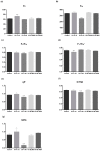Physiological, Biochemical and Molecular Assessment of UV-A and UV-B Supplementation in Solanum lycopersicum
- PMID: 34063679
- PMCID: PMC8147646
- DOI: 10.3390/plants10050918
Physiological, Biochemical and Molecular Assessment of UV-A and UV-B Supplementation in Solanum lycopersicum
Abstract
Daily UV-supplementation during the plant fruiting stage of tomato (Solanum lycopersicum L.) growing indoors may produce fruits with higher nutraceutical value and better acceptance by consumers. However, it is important to ensure that the plant's performance during this stage is not compromised by the UV supplement. We studied the impact of UV-A (1 and 4 h) and UV-B (2 and 5 min) on the photosynthesis of greenhouse-grown tomato plants during the fruiting/ripening stage. After 30 d of daily irradiation, UV-B and UV-A differently interfered with the photosynthesis. UV-B induced few leaf-necrotic spots, and effects are more evidenced in the stimulation of photosynthetic/protective pigments, meaning a structural effect at the Light-Harvesting Complex. UV-A stimulated flowering/fruiting, paralleled with no visible leaf damages, and the impact on photosynthesis was mostly related to functional changes, in a dose-dependent manner. Both UV-A doses decreased the maximum quantum efficiency of photosystem II (Fv/Fm), the effective efficiency of photosystem II (ΦPSII), and gas exchange processes, including net carbon assimilation (PN). Transcripts related to Photosystem II (PSII) and RuBisCO were highly stimulated by UV supplementation (mostly UV-A), but the maintenance of the RuBisCO protein levels indicates that some protein is also degraded. Our data suggest that plants supplemented with UV-A activate adaptative mechanisms (including increased transcription of PSII peptides and RuBisCO), and any negative impacts on photosynthesis do not compromise the final carbohydrate balances and plant yield, thus becoming a profitable tool to improve precision agriculture.
Keywords: fruiting stage; indoor growth; photosynthesis; tomato; ultraviolet supplementation.
Conflict of interest statement
The authors declare no conflict of interest.
Figures






Similar articles
-
Tomato plants use non-enzymatic antioxidant pathways to cope with moderate UV-A/B irradiation: A contribution to the use of UV-A/B in horticulture.J Plant Physiol. 2018 Feb;221:32-42. doi: 10.1016/j.jplph.2017.11.013. Epub 2017 Dec 6. J Plant Physiol. 2018. PMID: 29223880
-
Impaired leaf CO2 diffusion mediates Cd-induced inhibition of photosynthesis in the Zn/Cd hyperaccumulator Picris divaricata.Plant Physiol Biochem. 2013 Dec;73:70-6. doi: 10.1016/j.plaphy.2013.09.008. Epub 2013 Sep 18. Plant Physiol Biochem. 2013. PMID: 24077231
-
Sub-high Temperature and High Light Intensity Induced Irreversible Inhibition on Photosynthesis System of Tomato Plant (Solanum lycopersicum L.).Front Plant Sci. 2017 Mar 16;8:365. doi: 10.3389/fpls.2017.00365. eCollection 2017. Front Plant Sci. 2017. PMID: 28360922 Free PMC article.
-
Light means power: harnessing light spectrum and UV-B to enhance photosynthesis and rutin levels in microtomato plants.Front Plant Sci. 2023 Sep 4;14:1261174. doi: 10.3389/fpls.2023.1261174. eCollection 2023. Front Plant Sci. 2023. PMID: 37731978 Free PMC article.
-
Impact of increasing Ultraviolet-B (UV-B) radiation on photosynthetic processes.J Photochem Photobiol B. 2014 Aug;137:55-66. doi: 10.1016/j.jphotobiol.2014.02.004. Epub 2014 Feb 15. J Photochem Photobiol B. 2014. PMID: 24725638 Review.
Cited by
-
Young Tomato Plants Respond Differently under Single or Combined Mild Nitrogen and Water Deficit: An Insight into Morphophysiological Responses and Primary Metabolism.Plants (Basel). 2023 Mar 5;12(5):1181. doi: 10.3390/plants12051181. Plants (Basel). 2023. PMID: 36904041 Free PMC article.
-
Novel elastomeric spiropyran-doped poly(dimethylsiloxane) optical waveguide for UV sensing.Front Optoelectron. 2024 Jul 15;17(1):21. doi: 10.1007/s12200-024-00124-4. Front Optoelectron. 2024. PMID: 39008156 Free PMC article.
-
Environmental conditions and nutritional quality of vegetables in protected cultivation.Compr Rev Food Sci Food Saf. 2025 Mar;24(2):e70139. doi: 10.1111/1541-4337.70139. Compr Rev Food Sci Food Saf. 2025. PMID: 39970014 Free PMC article. Review.
References
-
- Research and Market . World-Tomato-Market Analysis, Forecast, Size, Trends and Insights. IndexBox Inc.; Walnut, CA, USA: 2020.
-
- Torres Pineda I., Lee Y.D., Kim Y.S., Lee S.M., Park K.S. Review of inventory data in life cycle assessment applied in production of fresh tomato in greenhouse. J. Clean. Prod. 2020;282:124395. doi: 10.1016/j.jclepro.2020.124395. - DOI
-
- Wu Q., Su N., Shen W., Cui J. Analyzing photosynthetic activity and growth of Solanum lycopersicum seedlings exposed to different light qualities. Acta Physiol. Plant. 2014;36:1411–1420. doi: 10.1007/s11738-014-1519-7. - DOI
Grants and funding
LinkOut - more resources
Full Text Sources

